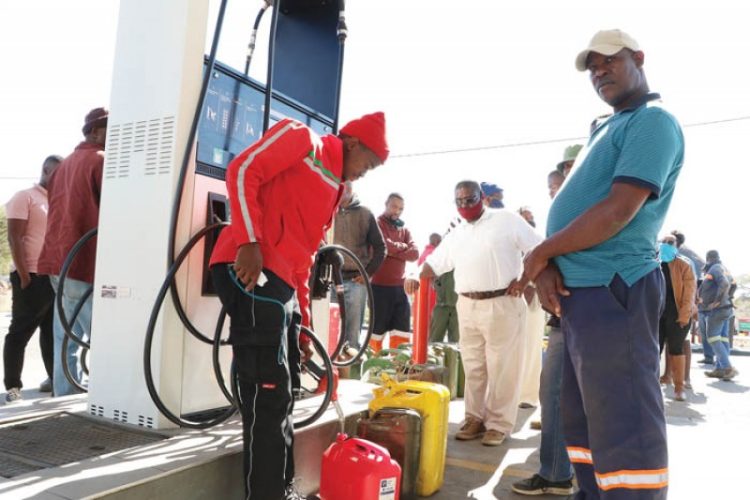BAMAKO, Nov. 1 — As the midday sun scorches the streets of Bamako, capital of Mali, the usual hustle and bustle has given way to long queues of vehicles stretching for hundreds of meters in front of gas stations.
Cars and motorcycles clog the main roads, with exhausted drivers dozing off behind the wheel or simply leaving the vehicles to hold their place in line.
Empty jerrycans and plastic bottles litter the roadside, the air blended with gasoline fumes and dust.
“The station has been out of fuel for three days,” said a staff member of Petro Mientao, a private gas station near King Fahd Bridge in Bamako.
“We’re just trying to keep order, but it’s hard to watch people wait helplessly.
” Motorcyclist Samba Diallo told Xinhua that he had been in line since the early hours of the day before, but the queue showed no sign of easing.
“These days, we rely on word of mouth to know which station might get new fuel,” Diallo said.
“Some stations post updates on social media, urging people to come when new supplies arrive.
” For nearly a month, the West African nation has been in the grip of a severe fuel shortage. Gasoline and diesel supplies have been drying up across the country, disrupting transportation, slowing business activities, and further straining daily life.
Fuel sales in Bamako and nearby areas are now rationed, capping each vehicle at 10,000 CFA francs (about 17.75 U.S. dollars) of fuel daily.
Though the official diesel price stands at 750 CFA francs per liter, black market prices have soared several times higher.
Observers say the shortage is closely linked to Mali’s fragile security situation.
Since September, the Group for the Support of Islam and Muslims (GSIM/JNIM) has repeatedly ambushed fuel convoys on major routes leading to Bamako from Senegal and Cote d’Ivoire.
These attacks have targeted economic lifelines to weaken the government and disrupt regional trade.
According to Mali’s security authorities, dozens of tanker trucks have been destroyed in such assaults.
The fuel crisis is now rippling through all sectors of society.
The national electricity company has warned that insufficient fuel supplies have sharply reduced the operation time of the thermal power plants.
In some areas, daily electricity supply has fallen from 19 hours to just six. Unstable power has forced many factories and offices to scale back or suspend operations.
An executive at Le Matin, a daily newspaper based in Bamako, said the printing press was barely functioning due to diesel shortages.
“We’ve cut our pages in half, and sometimes we can’t publish at all,” he said.
At Hospital of Mali in Bamako, patient visits dropped sharply, as many could not afford transport.
The ophthalmology department, which usually receives about 30 patients a day, now sees barely 20.
Of the four scheduled eye surgeries, only two were completed on time, with follow-up appointments postponed.
The government recently ordered a nationwide school closure from Oct. 27 to Nov. 9, and officials say the suspension may be extended.
Fuel scarcity has pushed up the cost of living. In Bamako’s Lafiabougou market, Kadiatou, a young housewife, said cooking oil prices rose by nearly a third within just a week, while the cost of onions and tomatoes doubled.
“Even transport to the market is more expensive. Life is getting harder,” she said. Vendors told Xinhua that transport costs have doubled or even tripled, forcing them to delay restocking goods.
The Malian government has launched an “Emergency Fuel Crisis Response Plan,” which includes military escorts for fuel convoys, creation of strategic fuel reserves, simplified import procedures, tax relief for energy companies, and priority fuel distribution to hospitals, emergency vehicles, and public transport.
The Malian armed forces have also intensified security operations nationwide to protect transport routes.
On Oct. 26, troops repelled an attack on a fuel convoy in the southern Bougouni region, killing several militants and seizing weapons.
Around 200 fuel trucks, escorted by security forces, arrived in Bamako between Oct. 26 and 27, a development many residents described as “a sign of hope.”
Analysts note that the crisis underscores Mali’s heavy dependence on external fuel supplies and its vulnerability to insecurity.
However, recent measures, including convoy escorts, emergency allocations, and strengthened regional cooperation, have begun to ease shortages in the capital and major cities.
With increased security along key routes and new deliveries arriving, early signs of stabilization are emerging.
Since a military coup in March 2012, Mali has grappled with instability and insurgency.
Although the government signed a peace and reconciliation agreement with some northern armed groups in 2015, violence has persisted in the north and spread toward central and southern regions in recent years.
by Xinhua writers Si Yuan, Wang Yue, Huang Wei(Xinhua)



